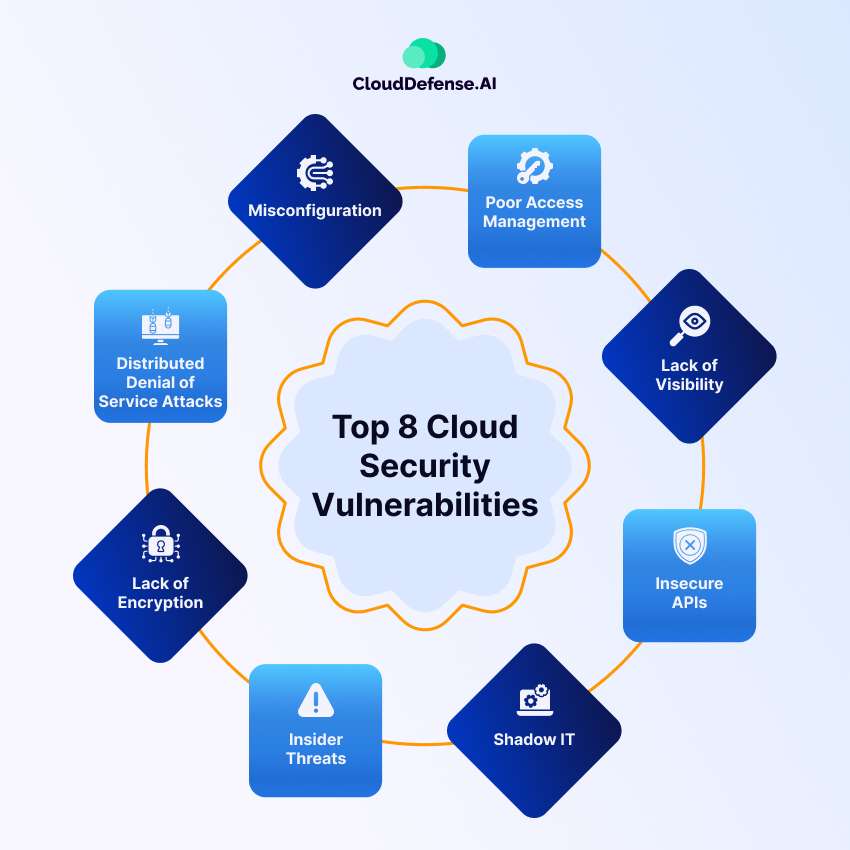The adoption of cloud hosting for storage and computing is on the rise, presenting both opportunities and challenges for organizations. However, with this increased reliance on cloud services comes a heightened risk of cyber attacks targeting vulnerabilities within these platforms.
According to a 2021 IBM study, data breaches from cloud security vulnerabilities incur substantial financial losses, averaging USD 4.8 million per incident. Beyond monetary implications, such breaches can also tarnish an organization’s reputation and erode customer trust.
In this blog, we’ll study the top eight cloud vulnerabilities, accompanied by real-life examples of attacks, and provide actionable tips to limit these risks effectively.
What are Cloud Vulnerabilities?
A cloud vulnerability refers to any weakness or gap present within a cloud computing environment that can be exploited by attackers. These vulnerabilities provide avenues for unauthorized access, data theft, or service disruption within the cloud infrastructure. They can stem from various factors such as misconfigurations, insecure authentication mechanisms, inadequate encryption practices, or software flaws within cloud-based systems.
Attackers often target these vulnerabilities as they represent relatively easier entry points into cloud environments. Despite being recurrent and well-known, many organizations fail to adequately address these vulnerabilities due to a lack of awareness about the risks involved or a deficiency in understanding how to effectively reduce them.
Top 8 Cloud Security Vulnerabilities

Here are the top eight cloud security vulnerabilities that you need to be aware of:
- Misconfiguration
- Poor Access Management
- Lack of Visibility
- Insecure APIs
- Shadow IT
- Insider Threats
- Lack of Encryption
- Distributed Denial of Service Attacks
We’ll discuss each of these in detail, describing the vulnerabilities, and providing real-life examples, together with tips on how you can prevent and mitigate them.
1. Misconfiguration
Cloud misconfigurations refer to errors or oversights in the setup and security settings of cloud-based applications, systems, and resources. These misconfigurations can occur across various components such as virtual machines, containers, serverless environments, and infrastructure as code. They often stem from administrative mistakes, rapid development cycles, lack of awareness, and misunderstandings about security requirements.
Real-life Example
In 2022, McGraw Hill experienced a significant data breach due to a misconfigured AWS S3 bucket. Approximately 22 TB of data, including sensitive student information, was exposed to unauthorized access for several years.
This misconfiguration allowed hackers to potentially access and exploit around 117 million files, highlighting the consequences of cloud misconfigurations.
To Prevent this Threat
- Enforce Least Privilege Access: Implement the principle of least privilege for all cloud resources and users to restrict access to only necessary permissions.
- Regularly Audit with CSPM Tools: Utilize cloud security posture management tools to conduct regular audits and remediate misconfigurations in cloud environments.
- Implement Infrastructure as Code (IaC): Incorporate IaC practices to maintain consistent and secure configurations across cloud resources, reducing the likelihood of misconfigurations occurring during deployment and provisioning processes.
Basic Mitigation Steps
- Secure Identity and Access Management (IAM): Ensure that IAM policies follow the principle of least privilege, regularly review access permissions, and utilize third-party tools for IAM policy scanning.
- Secure Data Storage: Keep data storage settings private by default, utilize third-party scanning tools to detect vulnerabilities, and implement peer review processes for infrastructure-as-code files to minimize the risk of public data storage misconfigurations.
- General Security Best Practices: Enforce HTTPS for data transmission, restrict unnecessary inbound and outbound ports, and centralize secret management using secure solutions like AWS Secrets Manager to minimize the risk of exposing sensitive information due to misconfigurations.
2. Poor Access Management
Poor access management vulnerabilities arise from weaknesses in identity access management practices, including insufficient authentication mechanisms, inadequate access controls, and misconfigured policies. These vulnerabilities create opportunities for threat actors to exploit digital identities within cloud environments, leading to unauthorized access, data breaches, and lateral movement within IT infrastructures.
Real-life Example
In the Broward Health data breach, overprivileged third-party access led to the compromise of 1.3 million patients’ records. Cybercriminals exploited this vulnerability to gain unauthorized access, resulting in the exposure of sensitive personal and medical information.
The breach underscores the significance of addressing poor access management practices to protect sensitive data and prevent unauthorized access incidents.
To Prevent this Threat
- Implement Least Privilege Access: Restrict user permissions to the minimum necessary level required to perform their duties, reducing the likelihood of unauthorized access or privilege escalation.
- Utilize Role-Based Access Control (RBAC): Grant users permissions based on their roles and responsibilities, ensuring that individuals only have access to resources essential for their tasks.
- Adopt Multi-Factor Authentication (MFA) and Single Sign-On: Implement MFA solutions to add layer of authentication, requiring users to provide multiple forms of identification for access. SSO solutions streamline access management while enhancing security.
- Utilize Cloud Access Security Broker (CASB): Deploy CASB solutions to monitor and control access to cloud resources, ensuring visibility into user activities and enforcing security policies to prevent unauthorized access incidents.
Basic Mitigation Steps
- Implement Multi-Factor Authentication (MFA): Require users to present at least two forms of identification validation, such as passwords and one-time codes, to access accounts or data.
- Enforce MFA Across the Organization: Mandate the use of MFA for all employees accessing cloud accounts and data, enhancing security against unauthorized access attempts.
3. Lack of Visibility
The lack of visibility vulnerability refers to the challenge of maintaining comprehensive insight into the entirety of an organization’s cloud infrastructure. In environments where cloud technologies are sourced from multiple providers and constantly evolving, the absence of centralized, context-based visibility can impede the identification, prioritization, and mitigation of security vulnerabilities. This creates a scenario where vulnerabilities may exist undetected, posing significant risks to data security and operational integrity.
Real-life Example
Toyota Japan experienced a data exposure incident where the personal and vehicle data of 2.15 million customers were unknowingly exposed for nearly a decade due to a cloud misconfiguration.
This prolonged exposure highlights the consequences of a lack of visibility, as Toyota could have identified and addressed the misconfiguration earlier with better insight into their cloud ecosystem.
To Prevent this Threat
- Monitor and Detect Threats: Employ monitoring solutions to continuously scan for potential security threats and anomalies within the cloud infrastructure.
- Ensure Visibility into Cloud Infrastructure: Implement tools and processes that provide comprehensive visibility into all aspects of the cloud infrastructure, including assets, configurations, and activities.
- Utilize Cloud-Native Application Protection Platforms (CNAPP): Use CNAPP solutions to gain insights into cloud assets and activities, enabling faster detection and response to security incidents.
Basic Mitigation Steps
- Implement Centralized Logging and Monitoring: Deploy centralized logging and monitoring solutions across all cloud resources to capture and analyze relevant data for security monitoring and incident response.
- Employ Cloud-Native Application Protection Platforms (CNAPP): Integrate CNAPP solutions into the cloud infrastructure to enhance visibility and threat detection capabilities, reducing the risk of undetected vulnerabilities and breaches.
- Set up Alerts for Unusual Activities: Configure alerts for unusual or unauthorized activities within the cloud environment, enabling prompt investigation and response to potential security incidents.
- Regularly Review and Prune Resources: Conduct regular reviews of cloud resources to identify and remove unnecessary or outdated assets, reducing the attack surface and minimizing the risk of vulnerabilities going undetected.
4. Insecure APIs
Insecure API vulnerabilities refer to weaknesses or flaws in the design, implementation, or configuration of cloud APIs that can be exploited by threat actors to gain unauthorized access, manipulate data, or launch attacks. These vulnerabilities may arise from suboptimal access controls, weak authentication mechanisms, incorrect rate limits, or accidental data exposure within the API infrastructure.
Real-life Example
The Optus data breach in 2022 serves as a poignant example of the risks associated with unsecured APIs. The breach occurred due to an unsecured and publicly available API that lacked authentication protocols, allowing threat actors to compromise sensitive records of approximately 10 million customers.
This incident highlights the significant impact of API vulnerabilities on data security and privacy.
To Prevent this Threat
- Implement Strong Authentication and Authorization: Enforce strong authentication and authorization mechanisms for cloud APIs to ensure that only authorized users and applications can access sensitive data and resources.
- Use Rate Limiting and Other Controls: Employ rate limiting and other access controls to prevent abuse and unauthorized access to APIs, thereby reducing the risk of exploitation by malicious actors.
- Regularly Scan APIs for Vulnerabilities: Conduct regular vulnerability assessments and scans of APIs to identify and remediate any security weaknesses or misconfigurations that could be exploited by attackers.
Basic Mitigation Steps
- Implement a Web Application Firewall (WAF): Deploy a WAF to filter incoming requests based on IP address or HTTP header information, detect and block code injection attacks, and enforce response quotas to mitigate the risk of API abuse.
5. Shadow IT
Shadow IT refers to the unauthorized use of cloud assets by individuals or departments within an organization without the approval or oversight of the IT department. This practice poses several risks, including financial implications, data loss, and compromised security due to the use of unauthorized services and applications.
Real-life Example
The data breach at Target in 2013 is a notable example that could be linked to Shadow IT. The breach, facilitated by compromised access from an HVAC vendor, underscores the risks associated with third-party connections that bypass IT oversight. This unauthorized access point provided attackers with entry into Target’s network, leading to the exploitation of vulnerabilities and the theft of sensitive data.
To Prevent this Threat
- Establish Business-Specific Security Policies: Develop security policies customized to the organization’s needs and objectives to govern the acceptable use of cloud resources and prevent unauthorized access.
- Use Access Controls: Implement strong access controls across cloud environments to regulate the provisioning of IT assets, restrict unauthorized usage, and monitor for potential breaches or anomalies.
Basic Mitigation Steps
- Eliminate Shadow Code: Identify and remove unauthorized code or applications used by developers without proper authorization or oversight.
- Design Business-specific Security Policies: Craft security policies that align with the organization’s requirements and regulatory obligations, ensuring adherence to established standards and best practices.
6. Insider Threats
Insider threats refer to vulnerabilities associated with individuals or entities who possess some level of access to an organization’s IT environment. These insiders could include current or former employees, third-party vendors, or partners. Insider threats may arise from accidental errors, negligence, or malicious intent, posing significant risks to an organization’s cybersecurity posture.
Real-life Example
The Capital One breach serves as a good example of the impact of insider threats. Engineered by a former employee of Amazon Web Services, this breach compromised the data of millions of individuals and incurred significant remediation costs.
The insider’s knowledge of cloud computing vulnerabilities enabled them to exploit Capital One’s Amazon cloud infrastructure, highlighting the potent threat posed by insiders with technical expertise.
To Prevent this Threat
- Monitor Employee Activity: Use monitoring systems to detect and investigate suspicious behavior among employees, enabling timely intervention in the event of potential threats or security incidents.
- Implement Strict Access Controls: Enforce stringent access controls across IT systems, even for trusted insiders, to limit unauthorized access and prevent data breaches or misuse of resources.
- Conduct Background Checks: Conduct thorough background checks on employees with critical access to sensitive data or systems, reducing the likelihood of insider threats and enhancing security posture.
Basic Mitigation Steps
- Provide Security Awareness Training: Offer regular security awareness training to employees to educate them about potential risks and best practices for protecting sensitive data and IT resources.
- Implement Strict User Access Controls: Control and restrict access to critical systems and data through strict user access controls, minimizing the risk of insider threats and unauthorized access.
- Address Misconfigured Cloud Servers: Regularly audit and address misconfigured cloud servers, as these errors can often go undetected and pose significant security risks to organizations.
7. Lack of Encryption
The lack of encryption vulnerability in cloud storage refers to the absence of cryptographic protection for sensitive data stored within the cloud environment. Without encryption, unauthorized individuals can potentially access and exploit sensitive information if they infiltrate the cloud infrastructure. Encryption serves to transform data into an unreadable format, requiring an encryption key for decryption, thus enhancing data security and privacy.
Real-life Example
The Equifax data breach serves as a stark illustration of the consequences of the lack of encryption. The breach compromised the personal data of millions of individuals, intensified by Equifax’s storage of sensitive data without encryption.
This oversight significantly magnified the impact of the breach, highlighting the importance of encryption in protecting sensitive information.
To Prevent this Threat
- Encrypt Data in Transit and at Rest: Employ encryption mechanisms to protect data both during transmission between systems (encryption in transit) and while stored on disk or other storage mediums (encryption at rest).
Basic Mitigation Steps
- Encryption in Transit: Configure systems and data stores to only allow access via secure protocols, such as HTTPS, to prevent unauthorized access to data during transmission.
- Encryption at Rest: Implement full disk encryption (FDE) for virtual machine disks and utilize AES256 encryption for maximum security. Additionally, consider employing Transparent Data Encryption (TDE) to secure databases while in use.
8. Distributed Denial of Service Attacks
Distributed Denial of Service (DDoS) attacks are malicious attempts to disrupt the availability of a web service, such as a website, by overwhelming the server with a flood of requests from various sources. These attacks aim to render the server unresponsive to legitimate user requests, thereby causing service downtime and impacting user experience.
Real-life Example
In February 2020, AWS reported mitigating a massive DDoS attack with incoming traffic peaking at 2.3 terabits per second. The attackers utilized hijacked CLDAP web servers to orchestrate the attack, highlighting the potency of DDoS attacks and the vulnerabilities they exploit.
To Prevent this Threat
- Choose a Cloud Provider with DDoS Protection: Select a cloud provider that offers strong protection against DDoS attacks, such as AWS Shield, which integrates seamlessly with cloud services and incurs no additional cost.
- Enable DDoS Protection: Ensure that DDoS protection features on your cloud service are always enabled to reduce the impact of potential attacks and protect service availability.
Basic Mitigation Steps
- Implement Comprehensive Security Measures: Deploy advanced security solutions, such as CrowdStrike’s unified and automated security platform, to protect against and minimize the impact of DDoS attacks, as well as other cloud security threats.
How Can CloudDefense.AI Help Counter These Vulnerabilities?
CloudDefense.AI offers an all-in-one suite of tools and solutions designed to address a wide range of cloud vulnerabilities that also include the ones mentioned above. Here’s how CloudDefense.AI can help secure your cloud infrastructure.
Hacker’s View™ and Noise Reduction
CloudDefense.AI’s Hacker’s View™ provides insights into potential weak points and pathways of invasion, allowing organizations to anticipate attacks. Noise Reduction technology prioritizes high-impact threats, enabling efficient risk management.
Code to Cloud Integration
CloudDefense.AI smoothly integrates with development processes, embedding security best practices from code to cloud. This ensures that vulnerabilities are identified and addressed early on, preventing them from spreading further.
Complete IaC Security Assurance
CloudDefense.AI’s IaC security scanning identifies misconfigurations and secrets, ensuring continuous governance and security throughout the development lifecycle.
Automated Misconfiguration Fixes
CloudDefense.AI automatically resolves misconfigurations by generating pull requests, streamlining the process of fixing security issues without manual intervention.
Real-Time Threat Detection and AI-Based Remediation
CloudDefense.AI offers real-time threat detection and uses AI-based remediation to proactively identify and address security threats, minimizing the risk of data breaches and unauthorized access.
Hassle-Free Compliance Management
CloudDefense.AI simplifies compliance management by deploying best security practices and adhering to regulatory requirements, ensuring that organizations can maintain compliance effortlessly.
Support for Multi-Cloud Environments
CloudDefense.AI is compatible with various cloud platforms, including AWS, Azure, and GCP, making it suitable for organizations operating in multi-cloud environments. It provides continuous scanning for misconfigurations and ensures easy compliance across different cloud providers.
By offering multiple tools in one platform, CloudDefense.AI gives organizations the power to effectively reduce cloud vulnerabilities, enhance security posture, and maintain compliance with regulatory standards. Book a free demo now to witness the future of cloud security!







